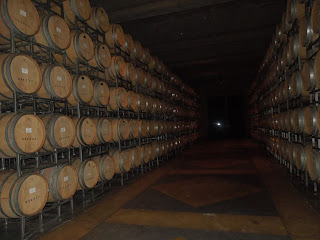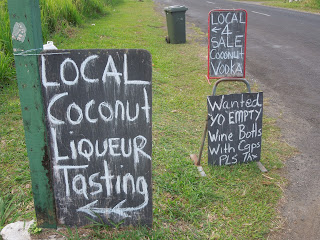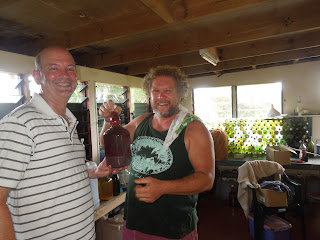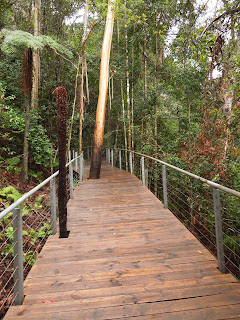It must have been the longest Monday ever. After 10 hours of flying from Auckland, we
arrived in Santiago five hours before we left.
It was 11.00am and we still had the whole day left – in which to get
completely lost (twice) and set alarm bells ringing (once).
We arrived in Chile with a desire to try the country and its wines, plus a splattering of
phrasebook Spanish. Not enough to
understand the instructions on the ATM, but enough to understand the word
‘invalid’ as our card was spewed back out.
‘We’ll find another ATM on the way,’ said Eddie, looking at the long
queue behind us.
He forgot – this is Chile.
We picked up our hire car no problem, paying extra for automatic
tolls, to make life easier if we found ourselves on a toll road. If only we’d known . . .
After some mad navigation and spotting a sign between two
lorries, we did find ourselves on the right road. With no map (‘oh, we can pick one up there’ –
more famous last words from Eddie) and only Google instructions to guide us, it
was a piece of luck, rather than judgment (I was still trying to work out where
we were supposed to travel 8 meters before taking a left fork).
Turned out to be a toll road. By the time we’d worked out which lanes were
for automatic payment, it was too late – we were in the cash only lanes. Without cash.
But, with broken Spanish, we managed to explain that we’d got into the
wrong lane and couldn’t pay. Supervisors
were called and after a lot of gesticulation and a few broken English words to
go with our broken Spanish, they let us through, waving to the right – we
assumed that was because that was the way the road went. Not so.
We found ourselves at another toll, but this time we went
through the automatic lane. ‘Funny how
no one uses these lanes,’ said Eddie as the barrier lifted. Then we approached the red light by a booth, assumed it would change to green as we went through, and carried on. The light stayed red, a barrier crashed
onto our windscreen as Eddie screeched to a halt, while a whole load of alarm
bells rang. By the time we’d reversed
away from the barrier, we were surrounded.
Well, not quite. We
only had to try and explain ourselves to two attendants. They were very understanding, looked at our
hire car contract and pointed out that we did not have automatic payment, that
we still had to pay. ‘Ah, but we have no
money.’
I think we said that in English. And they managed to tell us that we needed to
take the ‘free road.’ Fine, we thought,
we’d carry on and exit right – maybe that’s what they were trying to tell us at
the last toll. No. We had to go back the way we’d come, back
through the tunnel and take the road to Cuesta Hapita. By reversing back through the express toll
lane, waiting while some bollards were helpfully removed for us, then dashing
across during a gap in on coming traffic, through the central reservation and
back on our way. As I've mentioned - this is Chile.
We decided it would be a good idea not to miss our exit.
So we went back through the tunnel and took the wrong
exit. But we got the right one next time
– only to be faced with two options at the end of the slip road, left or right.
We chose left. It did take us in the right direction back
along the toll road, but the tar soon ran out and we were bouncing along a
gravel road at about 20kmph. This is
what comes of not having cash for the toll roads we thought, but the road ended
back at the toll road, the only option being a rough track up to what must be
private house.
That what when the pick-up stopped by, a window wound down
and a friendly voice asked if we needed help.
‘Si!’ I said.
‘Do you speak English?’ said Eddie.
Turned out he did.
And very well. Also turned out he
lived in the house up there through the entrance and had spotted us as he was
coming home.
‘I recognized that look!’ he said. ‘It’s that WHAT? look I have in a
foreign country! Where are you from?’
So we told him we were on a three month southern hemisphere
get away from the winter around the world wine tour. He said we were brave. (Funny how people in the UK kept saying that
as well.) He gave us details of a great
winery nearby with a good restaurant.
Then he explained that we should have gone right after coming off the
toll road and the free road had spectacular views. I’m glad he told us.
 |
| This is what you get if you don't have cash for tolls in Chile |
The road wound its way upwards until we had a spectacular view of the valley with the toll road running straight through it below. (this is when I noticed that our hire car had a windscreen wiper missing, but that’s another story . . .) It took us ten minutes to get as far as the tunnel, about five before we’d reached the end of it and another five before we spotted the fateful toll booth far below. Luckily we had a full tank of petrol this time – and plenty of time. And very lucky that we’d met our knight in shiny pick-up or we’d never had thought we were on the right road.
 |
| But you do get wonderful views from the Chilean non-toll roads |
But it took us on a lovely journey through vineyards (very tempting to stop for a taste) to Casablanca, where we found three banks with banks with defunct ATM’s. But the fourth one worked and this time we managed to press the right buttons (at the third attempt) and received a wad of notes. Just as well, as the road to Algarrobo, where our hotel was (or so we thought) was a toll road. How lovely to hand one of our notes over, receive a bundle of notes and be on our way.
A different way to the googlemap directions. But I knew our hotel was on a road into Algorrobo, so all we had to do was take the roads out and see if we could find it. There aren’t many roads out of Algorrobo, but our hotel wasn’t on any of them. So we stopped by a taxi and asked.
The driver couldn’t have been more helpful. After I’d used my limited Spanish to ask for directions and received a comprehensive but incomprehensible reply, he kindly drew us a map, with mucho explanation, but enough for me to get the gist.
The hotel was nowhere near Algarrobo. Just as well I understood that we had to go on roads that went up and down and round and round.
We were just wondering whether he’d misunderstood and sent
us to a different hotel with the same name.
Then we came across our hotel.
When I booked it through
booking.com, I hadn’t
realized that it was in the middle of nowhere.
And tiny. More of a large
house. And beautiful. And so peaceful. With spectacular views.
 |
| The view over the pool of Le Mirage Picador |
We managed to check in with our limited Spanish, into our
lovely room with duvets that, according to the bilingual hotel information, had
been designed for maximum guest comfort.
Eddie thought we should go back into Algarrobo, to try and
sort out the windscreen wiper, find an internet café . . .
But I was already under the duvet. Woke up two ours later – and it was still only
5pm on Monday . .
But a few hours later we were in the restaurant, the only
customers, chatting to the wonderful cook and drinking a bottle of local
Tunquen sauvignon blanc. The windscreen wipers
could wait.


















































